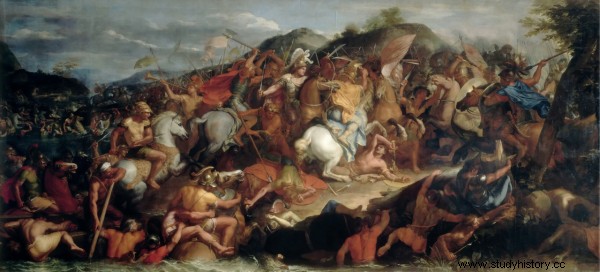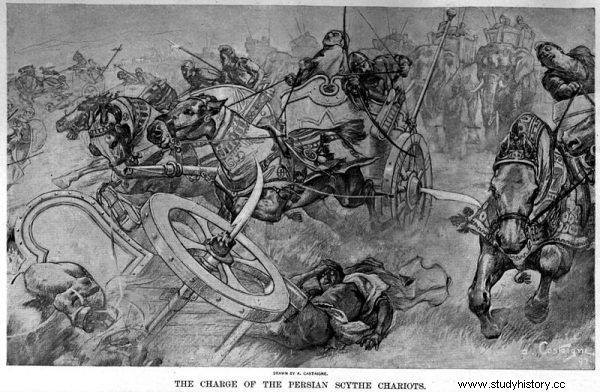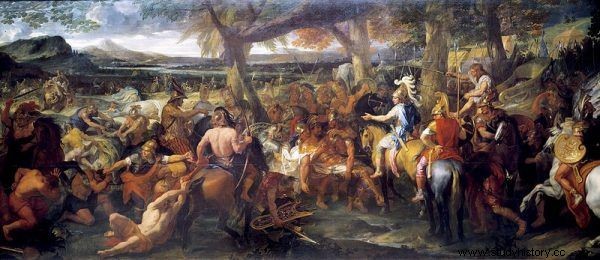Alexander the Great did not lose a single battle. These are the most important skirmishes he fought during his campaigns.
Alexander's father, Philip II (born 382 BCE in Pella, died 336 BCE in Ajga) left his son a powerful army and a strong, reformed state. After consolidating his position by suppressing revolts in Greek cities, the ambitious strategist set off to conquer Persia. He himself did not hesitate to lead the front ranks during the battle, leading the hetairs. At its peak, his kingdom was 5,000 kilometers wide.
The campaign in Persia was of course the longest period of conquest:
If you take into account the difference in material resources, population reserves and territorial size of Macedonia and the Persian Empire, Alexander's expedition is perhaps the most extraordinary military undertaking in the history of the world.
- we read in the monograph of Alexander the Great by Krzysztof Nawrotka.
It is also worth remembering that in the 3000 years of written history of Iran, this country has only been successfully attacked and conquered twice from the west [...].
It was here that a series of skirmishes took place, in which Alexander proved his perfect command.
Clashes in Persia
The first clash with the forces of King Darius, who ruled in Persia at that time, took place on the Granik River (334 BCE). Alexander then sent a small part of his cavalry ford across the water, which was only a ruse :when the Persians repelled this attack, the Macedonian commander himself, on his horse, Bucephalus, led the charge straight into the enemy ranks. He almost died then! Eventually, however, the Persians succumbed and dispersed. Alexander had an army of 6,000 cavalry and 43,000 infantry, the opponents deployed 15,000 cavalry and 15,000 infantry, including 5,000 Greek mercenaries.

The Battle of Granik started a series of successes in Asia
In 333 B.C.E. Alexander's forces attacked other Persian cities, and finally in November they had to face Darius III once again. The troops gathered near the city of Gordion, the fighting took place in a narrow isthmus above the Pinaros River, in the Bay of Issos. The Persians strengthened their positions by taking advantage of the relief and barricading over the water. According to historical sources, there were supposed to be about 600,000 of them, but nowadays this number is considered greatly exaggerated :more likely Dariusz had around 100,000.
Alexander again bet on the surprise tactic:he led the ferocious charge straight to the right flank of the Persians. The defenders fired one volley of their bows and then escaped . Macedonian cavalry broke through the ranks of enemies and fell on the bodyguard of Darius standing in the center and the Greek mercenaries fighting in his army. A fierce battle broke out around the Persian king, in which Alexander himself was mildly wounded. Finally, fearing capture by Macedonians, Darius ran away. At that time Macedonian support for Alexander came from the river - the battle was won.
On his way through Persia, Alexander came across one city whose inhabitants decided to resist . It was Tire, on an island with a massive fleet of ships. The siege lasted six months, during which time Alexander's soldiers built a causeway connecting the shores, as well as about 200 ships. After breaking a fragment of the walls with siege machines, Macedonian forces attacked - first from the dike, and then from the decks of ships. The city was captured, the men were murdered, and the women and children were captured.
Soon it was time for another meeting between Aleksander and Dariusz. The rulers met again in 331 BCE, when the king of Persia managed to gather another army:he raised about 200,000 people (including 200 chariots equipped with scythes, there are disputes about the number of horses - there could be from 45 to 160; Persians they also had 15 elephants) against Alexander's approximately 47,000 soldiers. The clash took place near Gaugamela (sometimes the Battle of Arabela is also referred to as Gaugamela was a small settlement), where the flat terrain favored Darius' enormous outnumbering. But Alexander had outsmarted him again :along with the best horsemen, he rode towards the right flank, decentralizing the Persian formations reacting to his move. Then, leaving his small troops behind as cover, he struck at the gap created by this in the ranks of the enemies. Dariusz, seeing his army split into two parts, decided to evacuate, which resulted in the final dispersion of the Persian army. The king escaped with his life, taking advantage of the weakened flank of Macedonians.

Charge of Persian Scythian chariots under Gaugamela
Alexander won the crown of Persia at Gaugamela, but the resistance from the Persians continued . The conqueror had to go deep into their country, chasing King Darius in the Zagros Mountains. Here he split his forces, instructing Parmenion to walk around the dangerous mountain terrain and delve into them with a handful of select troops. He wanted to get to Persepolis as soon as possible, but the Persians once again tried to stop him by setting up an ambush in the valley known as the Persian Gate.
The only way back
Archers lined up on the slopes surrounding the path and some 40,000 soldiers under the command of Ariobarzanes prevented Alexander from crossing. Macedonian troops panicked under the hail of missiles . It was the first and only time that Alexander the Great had ordered a retreat. The losses were enormous, and the Macedonian leader faced a serious dilemma:he might still try to force the tight and dangerous passage, or take precious time to circumnavigate the mountains and join Parmenion.

According to many historians, the Battle of the Hydaspes was Alexander's greatest military feat
The previously captured Persians, however, revealed that there was a third alternative:a mountain path that the defenders had not manned. Alexander's forces moved without delay, at night, up the dangerous rocky road to the rear of the enemy. The next day, January 20, 330 B.C.E. Persian camps were attacked from the rear and Macedonian troops took their bloody revenge . Due to the similarity, this battle is often referred to as the Persian Thermopylae . Historians are uncertain as to the fate of the leader of Ariobarzanes - some claim that he fled and was never seen again, others that he fell in battle.
Spectacular success
But Alexander's greatest military feat was yet to come. In 326 BCE, during a campaign in India, there was a battle with King Porus of the Pauravians. The Macedonian at that time had 50,000, who stood against 60,000 and several dozen fighting elephants!
The clash took place on the river Hydaspes (today called Jhelum), and both leaders deployed their forces along its current, preventing each other from crossing over to the other side. Despite the fast current and difficult conditions for the crossing, Aleksander decided to do just such a maneuver. He took about 12,000 soldiers with him and wandered up the river at night. There he crossed using improvised rafts.
Meanwhile, its commander, Craterus, simulated attempts to cross the water, keeping Porus's army on constant tension. With darkness the situation relaxed, no one on Porus' side expected an attempt to attack in the dark, but ... Alexander's forces were already getting ready for the coming battle! After defeating the small formation of Porus' son, Young Porus, they moved on. A bloody fight ensued, with losses heavy on both sides, and misplaced battle elephants wreaking havoc on both sides. Eventually, Alexander and Craterus managed to surround Porus, who surrendered the battle.
This battle, widely regarded as Alexander's greatest achievement, was also one of the last . Soon, a disgruntled army forced the leader to return home. The invincible Macedonian planned more expeditions, but they did not come to pass:he died in Babylon in 323 BCE, the causes of death have not been clarified to this day.
